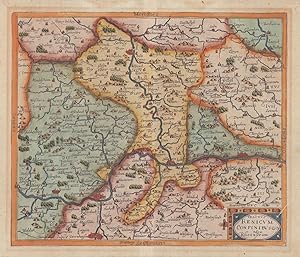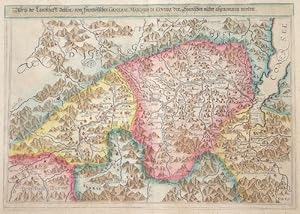Custos, David (3 results)
Product Type
- All Product Types
- Books (1)
- Magazines & Periodicals
- Comics
- Sheet Music
- Art, Prints & Posters (2)
- Photographs
- Maps
-
Manuscripts &
Paper Collectibles
Condition
- All Conditions
- New
- Used
Binding
- All Bindings
- Hardcover
- Softcover
Collectible Attributes
- First Edition
- Signed
- Dust Jacket
- Seller-Supplied Images (2)
- Not Printed On Demand
Seller Location
Seller Rating
-
Tractus Renicum Confinibus oder Rheijnstrom. -
Published by Frankfurt a.M.: Johann T. Schönwetter, []., 1627
Art / Print / Poster
Kupferstich, 26 x 31,5 cm Bildgröße, 31 x 37,5 cm Blattgröße. Der Kupferstich von David Custos in leuchtendem Altkolorit zeigt den Rheinlauf zwischen Speyer und Düsseldorf. Mittig im Bild die Mosel. Dabei ist Westen am oberen Bildrand, Osten am unteren, Norden an der rechten und Süden an der linken Bildseite. Frankfurt am unteren Bildrand, am oberen Saarburg. Unten rechts eine schlichte Titelkartusche, am unteren Bildrand der Verfasser. Aus: Michael Lundorp, Laurea Austriaca. Drei zarte Quetschfalten, leichte Bräune im Bereich des früheren Passepartoutausschnittes, rückseitig Spuren alter Einrahmung. Die Karte besticht durch das schöne, flächendeckende Altkolorit und durch die einfache, teils naiv anmutende Darstellung der geographischen Symbole für Wald und Berge.
-
Abriss der Landschafft Veltlin, vom frantzösischen General Marquis di Covure den Spanischen wieder abgenommen worden.
Published by Artist: Custos David ( - ) Frankfurt; issued in: Frankfurt on Main; Custos David ( 1600 - ) Frankfurt; David Custos the son of Dominicus Custos a Dutch illustrator engraver and publisher He continued to ran his father's company The son of the Flemish painter and poet Pieter Baltens (1527-1584) Custos was born in Antwerp in 1560 When he left his homeland after his father's death he adopted the name Custos In Augsburg in 1588 he married the widow of the goldsmith Bartholomew Kilian (1548-1588) Maria Pfeyffelmann With her he had three sons Raphael David and Jacob, 1600
Technic: Copper print; colorit: colored; condition: Perfect condition; size (in cm): 24,5 x 35; Map depicts the province Sondrio in Lombardia, northern Italy. With the cities Sondrio, Tirano, Morbegno, Dubino and the Lago die Mezzola, in those days a part of the lake Como. From: Östreichischer Lorbeerkrantz b. Nicolaus Bellus (Michael Caspar Lundorp). History: In ancient times, in northern Italy, unlike in southern Italy, there was hardly any Greek colonization. For the Roman Empire, Northern Italy was initially Gallia cisalpina. Since the Middle Ages, northern Italy has been characterized by remarkable trading cities, which, starting from the Veronese Confederation, united in the Lombardenbund against Emperor Barbarossa. At that time, some basics of business administration and banking, such as double-entry bookkeeping, were created in northern Italy. In pre-Roman centuries it was inhabited by different peoples among whom the Ligures, the ancient Veneti, who prospered through their trade in amber and breeding of horses, the Etruscans, who colonized Northern Italy from Tuscany, founded the city of Bologna and spread the use of writing; later, starting from the 5th century BC, the area was invaded by Celtic ? Gallic tribes. These people founded several cities like Turin and Milan and extended their rule from the Alps to the Adriatic Sea. Their development was halted by the Roman expansion in the Po Valley from the 3rd century BC onwards. After centuries of struggle, in 194 BC the entire area of what is now Northern Italy became a Roman province with the name of Gallia Cisalpina ("Gaul on the inner side (with respect to Rome) of the Alps"). The Roman culture and language overwhelmed the former civilization in the following years, and Northern Italy became one of the most developed and rich areas of the western half of the empire with the construction of a wide array of roads and the development of agriculture and trade. After the fall of the Western Empire, Northern Italy suffered heavily from destruction brought about by migration from Germanic peoples and from the Gothic War. In the 10th century Northern Italy was formally under the rule of the Holy Roman Empire but was in fact divided in a multiplicity of small, autonomous city-states, the medieval communes and maritime republic. The 11th century marked a significant boom in Northern Italy's economy, due to improved trading and agricultural innovations, culture flourished as well with many universities founded, among them the University of Bologna, the oldest university in Europe. In the end a balance of power was reached in 1454 with the Peace of Lodi and Northern Italy ended up divided between a small number of regional states, the most powerful were the Duchies of Savoy, Milan, Mantua, Ferrara and the Republics of Genoa and Venice, which had begun to extend its influence in the mainland from the 14th century onwards. In the 15th century Northern Italy became one of the centres of the Renaissance whose culture and works of art were highly regarded. After the French Revolution in the late 18th century Northern Italy was conquered by the French armies, many client republics were created by Napoleon and in 1805 a new Kingdom of Italy, made of all of Northern Italy but Piedmont that was annexed to France, was established with Milan as capital and Napoleon as head of state. In the congress of Vienna, the Kingdom of Sardinia was restored, and furthermore enlarged by annexing the Republic of Genoa to strengthen it as a barrier against France. The rest of Northern Italy was under Austrian rule, either direct like in the Lombardo-Venetian Kingdom or indirect like in the Duchies of Parma and Modena. Bologna and Romagna were given to the Papal State.
-
Italiae nova et exacta descriptio.
Published by Augsburg,, 1625
Seller: libreria antiquaria perini Sas di Perini, Verona, VR, Italy
Art / Print / Poster
Incisione in rame, 225x305. Non comune. Bell'esemplare. Borri, 91. Nr.cat: 774.




